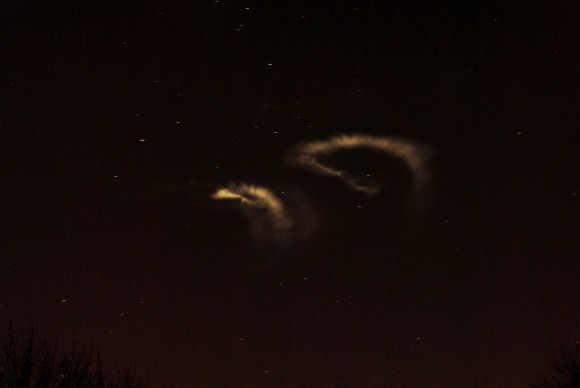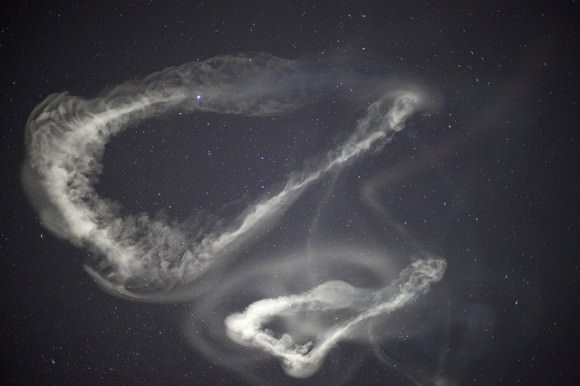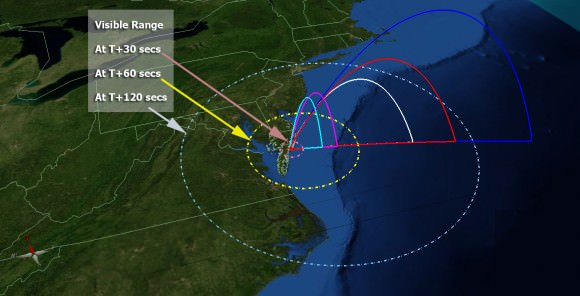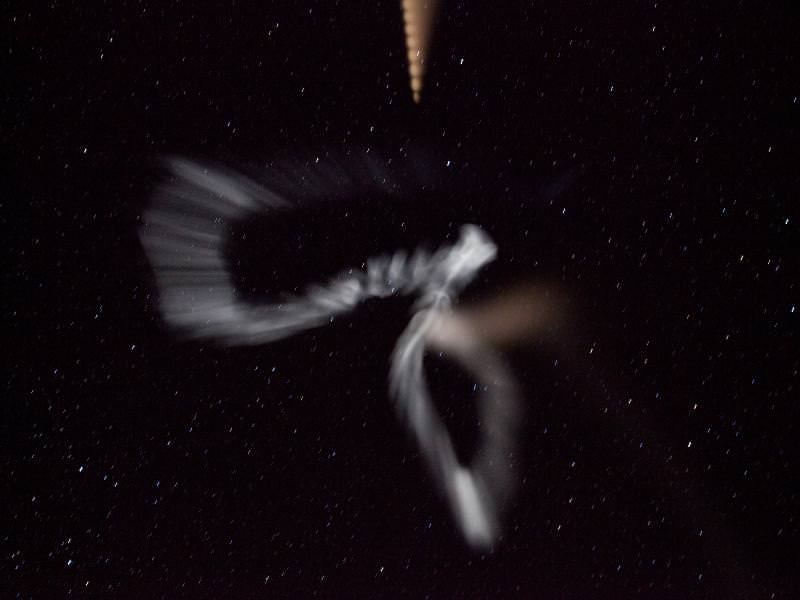[/caption]
After several days of delays due to weather and technical issues, NASA has now successfully launched five suborbital sounding rockets in five minutes from the Wallops Flight Facility in Virginia as part of a study of the upper level jet stream.
The first rocket was launched at 4:58 a.m. EDT and each subsequent rocket was launched 80 seconds apart.
Each of the rockets released a chemical tracer that created psychedelic-looking clouds at the edge of space, which were reported to be seen from as far south as Wilmington, N.C.; west to Charlestown, W. Va.; and north to Buffalo, N.Y.
The above image was taken from one of the official viewing sites by a NASA photographer; below is an image taken by John Anton from New Jersey, as well as more images from NASA, the video showing all the launches and time-lapse video from twolf1 on Vimeo.

The Anomalous Transport Rocket Experiment (ATREX) is a Heliophysics sounding rocket mission that gathered information to better understand the process responsible for the high-altitude jet stream located 95-105 km (60 to 65 miles) above the surface of the Earth.

Scientists from the mission had viewing sites at three locations: the launch site in Virginia, the Rutgers Marine Field Station in Tuckerton, N.J., and the U.S. Army Corps of Engineers at Duck, N.C. Clear skies at all three locations were a prerequisite for the rockets to be launched.
The sounding rockets were two Terrier-Improved Malemutes , two Terrier-Improved Orions and one Terrier-Oriole.
Chemical tracers from ATREX rockets launched from NASA’s Wallops Flight Facility in Virginia from twolf1 on Vimeo.

The high-altitude jet stream is higher than the one commonly reported in weather forecasts. The winds found in this upper jet stream typically have speeds of 320 to well over 480 km/hr (200 to over 300 mph) and create rapid transport from the Earth’s mid latitudes to the polar regions. This jet stream is located in the same region where strong electrical currents occur in the ionosphere. It is therefore a region with a lot of electrical turbulence, of the type that can adversely affect satellite and radio communications.
Not only did the rockets release the chemical tracers to allow scientists and the public to “see” the winds in space, but two of the rockets had instrumented payloads to measure the pressure and temperature in the atmosphere at the height of the high-speed winds. NASA will release more information on the outcome of the experiment after scientists have had time to review the data.
See a slideshow of images of the launches on Flickr from NASA


Hey look! A chemtrail!
Wowie! What an incredible experiment! I LIKE it. The idea of comprehensively mapping the E/M upper atmos. w/5 tracers is genius***** Yet, one wonders after the shape(s) of those releases? Do you detect patterns and spirals too? Then again, so much of any rocket contrail is illuminated by high inclination and distorted fantastically by nozzle ejection velocities, the upper jet stream, and solar dynamic or E/M field passage. It must be difficult at best to deconvolute all that into a field shape(s) statement?
“It is therefore a region with a lot of electrical turbulence, of the type that can adversely affect satellite and radio communications.”
One which we’ve only just begun to explore. We’ve come a long way since Edison’s first light bulb but now that we have *.sats orbiting Luna/La Selena and another the trio orbiting Sol., we can combine that data with data from the SRO and SOHO and get simultaneous 3D data! Yassss…. ~*~
CLOSE up is key here… long range photometry and RF detectorszuh…
Very interesting and fun article Nancy. Excellent images are certainly food for thought. Image from John Anton in NJ certainly shows versatility of experiment.
Watched from my front lawn this morning in Brick Township NJ, quite a sight, well worth staying up through the weather delays and fools who don’t read mariner notices, in times of strong climate concerns we need to understand our atmosphere as fully as possible.
Trimethyl aluminum… Really?
what are the health risks and damages to the jet stream and magnetosphere from these AL chemicals? aluminum is toxic to humans in more than needed trace amounts of micrograms. could this not fall back down on earth with environmental consequences yet unknown unseen?
http://holographicgalaxy.blogspot.com
what are the health risks and damages to the jet stream and magnetosphere from these AL chemicals? aluminum is toxic to humans in more than needed trace amounts of micrograms. could this not fall back down on earth with environmental consequences yet unknown unseen?
http://holographicgalaxy.blogspot.com